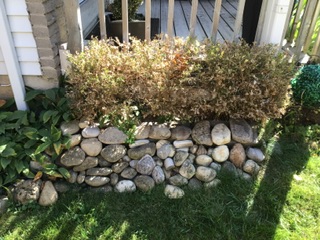
House in Toronto boxwoods in very narrow space at edge of porch used to camouflage fencing to keep critters out from under porch, faces west, gets afternoon sun.
WHAT CAN I PLANT TO REPLACE DEAD BOXWOODS, that will fill the space, but not grow large quickly??
Boxwoods shrubs have become trickier to care for with the emergence of the box tree moth on top of box tree blight and leaf miners. If you would like to replace these with something more resilient, you are in luck as there are many options. Here are a three that give you a similar look:
Ilex glabra
The closest boxwood lookalike you will find is inkberry holly. Inkberry holly has small, oval-shaped leaves that look more like a boxwood leaf than a traditional holly leaf that has spiny points. They are soft to the touch and won’t be scratchy when you walk by. Like boxwood, these evergreen plants can be sheared into balls, boxes and hedges.
Inkberry holly is native to coastal states from Maine to Texas and is hardy in zones 5-9. It grows a bit faster than boxwood but is not drought tolerant. It will be happiest in moist, acidic soil in sunny or partly shaded conditions. They reach 2-3’ tall.
Thuja occidentalis ‘Tator Tot’
Proven Winners offers this arborvitae which requires very little to no pruning to achieve a globe shape. They will grow up to 2’ tall unless you prefer to keep it slightly shorter by lightly shearing it back in spring. Full sun to part shade and well-drained soil are what this shrub needs to thrive in zones 3-7.
Taxus x media ‘Stonehenge Dark Druid’
This is a very versatile shrub as it grows well in either sun or shade. This cultivar, also from Proven Winners, forms a 2-3’ tall by 3’ wide mound of dark green, soft needlelike foliage. It retains its color beautifully through all four seasons and is very cold hardy, thriving in zones 4-7.
October 3, 2023

